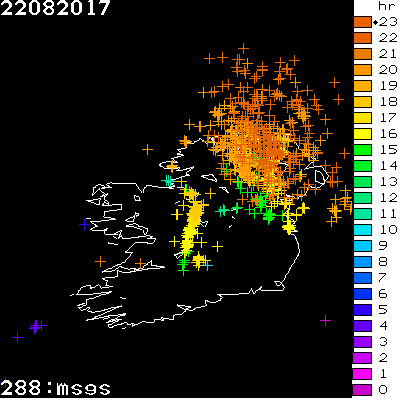LIGHTNING is a powerful sudden flow of electricity (an electrostatic discharge) accompanied by thunder that occurs during an electric storm. The discharge will travel between the electrically charged regions within a thundercloud, or between a cloud and a cloud, or between a cloud and the surface of a planet. The charged regions within the atmosphere temporarily equalise themselves through a lightning flash, commonly referred to as a strike if it hits an object on the ground.
There are three primary types of lightning:
- from a cloud to itself (intra-cloud or IC)
- from one cloud to another cloud (CC)
- between a cloud and the ground (CG)
Although lightning is always accompanied by the sound of thunder, distant lightning may be seen but may be too far away for the thunder to be heard.
A typical cloud to ground lightning flash culminates in the formation of an electrically conducting plasma channel through the air in excess of 5 kilometres tall, from within the cloud to the ground’s surface. The actual discharge is the final stage of a very complex process. On Earth, the lightning frequency is approximately 40–50 times a second or nearly 1.4 billion flashes per year and the average duration is 30 microseconds.
Conditions necessary for cloud formation
Lightning primarily occurs when warm air is mixed with colder air masses, resulting in atmospheric disturbances necessary for polarising the atmosphere.
In order for an electrostatic discharge to occur, two things are necessary:
- A sufficiently high electric potential between two regions of space must exist; It is well understood that during a thunderstorm there is charge separation and aggregation in certain regions of the cloud or cloud to ground; however the exact processes by which this occurs are not fully understood.
- A high-resistance medium must obstruct the free, unimpeded equalisation of the opposite charges. The atmosphere provides the electrical insulation, or barrier, that prevents free equalization between charged regions of opposite polarity. This is overcome by “lightning”, a complex process referred to as the lightning “flash”.
Lightning strike
Objects struck by lightning experience heat and magnetic forces of great magnitude. The heat created by lightning currents travelling through a tree may vaporize its sap, causing a steam explosion that bursts the trunk. Even though roughly 90 percent of people struck by lightning survive, the injury may by severe. Buildings or tall structures hit by lightning may be damaged as the lightning seeks unintended paths to ground. The use of lightning conductors allows the safe conduction of a lightning strike to ground.
Thunder
Because the electrostatic discharge of terrestrial lightning superheats the air to plasma temperatures along the length of the discharge channel in a short duration, kinetic theory dictates gaseous molecules undergo a rapid increase in pressure and thus expand outward from the lightning creating a shock wave audible as thunder.
Since the sound waves propagate not from a single point source but along the length of the lightning’s path, the sound origin’s varying distances from the observer can generate a rolling or rumbling effect.
Light travels at about 300,000,000 m/s. Sound travels through air at about 340 m/s. A lightning flash preceding its thunder clap by five seconds would be about one mile (1.6 km) (5×340 m) distant. A lightning strike observed at a very close distance will be accompanied by a sudden clap of thunder and possibly accompanied by the smell of ozone (O3).

